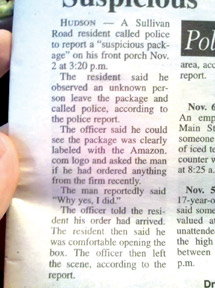|
Short paras and conciseness are ‘par’ for the course:
Bad grammar nailed by the editor’s hammer!
Gaston de Rosayro
|

Writing a news story |
Today we build on the lessons learned when writing the introduction.
Let us examine how you could use language to guide your reader or
listener through the information in a clear, concise and entertaining
way and through to the very end.
Simplicity after all is the key. As mentioned keep the language and
grammar clear and simple. This is not just a rule for intro writing - it
applies throughout the whole news story. A lot of young journalists
write bright, snappy intros with simple grammar and short words, then
spoil the story by overloading the rest with long and obscure words and
complicated grammatical constructions.
Here are a few additional tips for journalists that apply to writing
in general. These will help your writing to be clearer and easier to
understand. Words should not be too long or complicated. A news story is
not the place to try and impress people with your intelligence or your
command of the English language. Pick your words carefully so they are
concise and you will use fewer words overall.
Make sure your sentences are under 25 words and contain only one
idea. Use a simple subject verb object form and do not use too many
commas. Paragraphs need to say something new and, like sentences, be
short and to the point. Never put more than three prepositional phrases
into one sentence and never put more than three numbers in one sentence.
|

A news story with short paragraphs |
As you will learn, writing for journalism is quite different than
writing for an English class. But many of the fundamentals you learned
in English class still apply to journalism. Before you can be a good
journalist, you need to be a good writer and that means having a strong
grasp on grammar. Grammar is so important to journalism that some
journalism schools have entire courses devoted to grammar.
Why study grammar? Journalists need to be correct. Poor grammar turns
off readers. Journalists should be consistent – that requires rules.
Writing should be clear. You know what you mean, but do others?
Remember that the same factors which make a good intro also apply to
the whole of the story. Another way in which we help to keep things
simple for our readers or listeners is by writing paragraphs of one or
two sentences. You may have been told in writing essays that you only
start a new paragraph for a new idea. This does not apply in journalism,
where we try to get lots of ideas into a short space in a newspaper or
short bulletin on radio or television. It is standard practice in news
journalism to start a new paragraph with each sentence. We call each of
these short paragraphs a ‘par.’ You should get used to this term.
The great advantage of having short pars in radio scripts is that the
newsreaders have no trouble keeping track of where they are on the page.
When they finish one sentence, their eyes automatically move to the
beginning of the next par. In newspapers, short paragraphs introduce
white space on to the page, at the beginning and end of each par, which
makes the story more readable. It also makes the story easier on the
reader’s eye and easier to cut, if it is too long to fit on the page.
We have already mentioned that accuracy is one of the principal
requirements of journalism. You may have to generalise in your intro to
keep it short and simple. However, you must be accurate and precise when
giving the full details later in the story.
By identifying key points and ranking them in importance you have
placed the facts in some kind of order. Certainly this is the best
method to use for the intro and the first few paragraphs. However, with
a long and involved story you will find that jumping from key point to
key point may confuse your reader or listener. You will have to put your
facts in a logical sequence and provide continuity between different
segments of the story.
|

An example of writing a news story |
|

A news story appeared on a news paper |
Telling the story in chronological order will do this for some kinds
of events. But it will not work for all stories - for example an
election campaign or a debate over where to build a new playground.
These need a slightly different approach once you have written your
intro and principal key points.
Once you have written your intro and the paragraphs telling the
principal key points, take each aspect of the story in turn and give
details of it before moving on to the next aspect. Do not ramble from
key point to key point. Take your readers or listeners by the hand and
lead them through the story.
When you change from one aspect to another, you may occasionally have
to provide linking words to guide your audience such as however and
meanwhile: We quote examples: However, a spokesman for the workers said
they had a number of other complaints. Meanwhile, the Local Government
authority was preparing its own plans to fight the paddy blight. The
‘however’ in our first example says that we are about to hear an
opposing view to the one previously expressed. The ‘meanwhile’ in our
second example tells us that something else is going on at the same
time.
There are a number of other linking words which can give your story
continuity. Be careful. Each has a specific meaning, so get it right.
Also, remember that if you repeat ‘meanwhile’ ten times in a story you
will simply leave your readers or listeners confused, not knowing where
in the story they are. Get your facts first. Some stories involve both
the announcement of facts (such as an increase in income tax) and
comments on the facts themselves from the Finance Minister, opposition
leader and others.
You must always give sufficient explanation of the facts first to put
the comments in context, otherwise you will confuse your reader or
listener. For instance there is as usual a right way and a wrong way of
treating a story. This is the right way to tell your story about a tax
hike: “Income tax is to rise by two percent next month. The Finance
Minister, President Mahinda Rajapaksa said yesterday the rise was needed
to help to pay for increased spending on education. And here is the
wrong way to do it: “The Finance Minister said today that an increase in
income tax was needed to help to pay for increased spending on
education. President Mahinda Rajapaksa announced that income tax will
therefore rise by two percent from next month”.
To summarise then: Remember to read your story through thoroughly
before handing it in. If you find any errors, correct them - then read
it through again! Ask yourself the following questions: Have you
presented the facts in an orderly manner and provided links between
different segments? Where you have facts and comments, are the facts
first? If your story is a follow-up or part of a running story, have you
provided sufficient background information? Is everything you have
written accurate? Can you simplify any of the words or grammar to make
the story easier to understand? Have you used quotes to enliven the
story? Have you attributed the facts and opinions to the right people?
Have you read it through again?
In all, remember short paras are ‘par’ for the course in journalism.
And get your grammar right. If you do not, a professional editor would
be justified in nailing your career down with a hammer!
[email protected]
|



